Jacqueline Gilmore
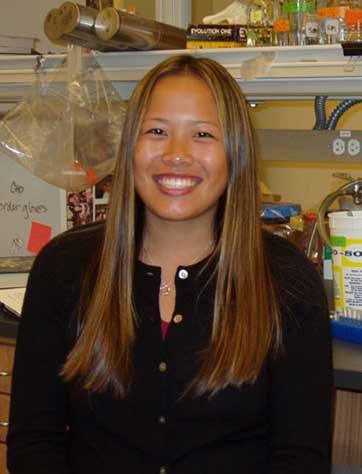
Proteases are a class of enzymes that cleave other proteins. Interestingly, the susceptibility of proteins to proteases differs, with some proteins being more resistant to proteolysis than others. The mechanism for this resistance is unclear. By studying model proteins that resist cleavage by the protease trypsin, Jacqueline hopes to determine the biophysical basis of proteolytic resistance. For her senior thesis in Molecular and Cell Biology, Jacqueline will study the structural properties of three resistant proteins from E. coli: potD, argT, and glnH. By utilizing recombinant DNA technology, protein purification methods, […]
Jihoon Lim
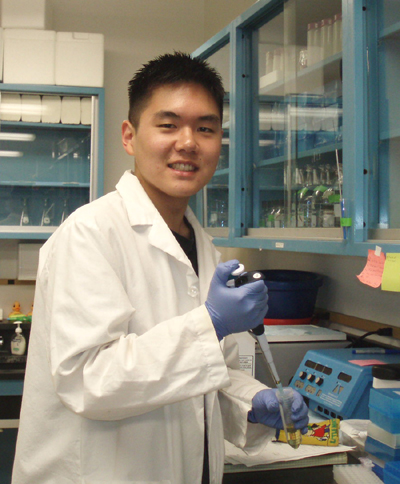
Salmonella typhimurium (S. typhimurium) is one of the leading causes of foodborne illnesses and mortalities. A major factor behind its virulence is its ability to survive well in the presence of hydrogen peroxide generated by macrophages through respiratory burst. Previous research has shown dsbD mutants of S. typhimurium to be more susceptible to hydrogen peroxide. DsbD works in conjunction with dsbA, B, and C in maintaining periplasmic disulfide bonds. More specifically, dsbD catalyzes the isomerase activity of dsbC by reducing it. DsbA and B help form disulfide bonds by oxidizing […]
Robert Chen
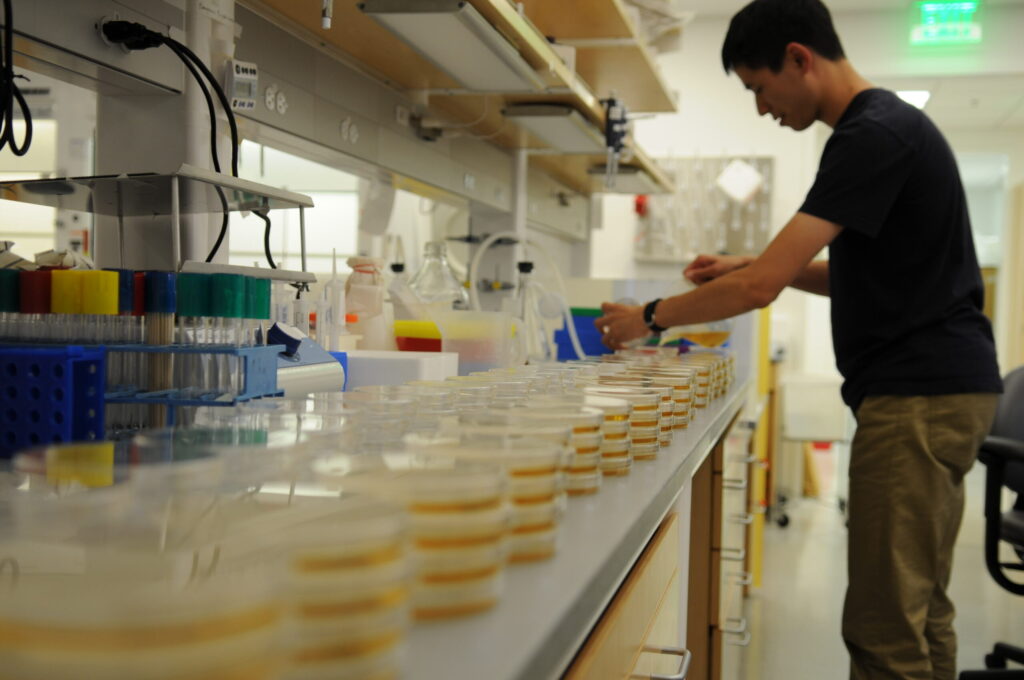
In the burgeoning field of genetic engineering, living systems are engineered to perform desired functions such as fighting cancer, sensing harmful chemicals, or producing useful compounds. However, cellular processes are unpredictable and genes do not always act as expected. In order to find a gene’s optimal setting, scientists currently need to search through “libraries”–large numbers of genetic variants–which is labor and time-intensive. Robert’s research centers on developing a new technology called MiCodes, or Microscopy Codes, which will speed up our ability to perform library screening under the microscope by barcoding […]
Sean Poi Lee
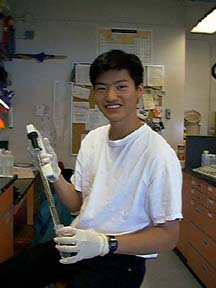
Sean’s project addresses two major questions in biochemistry: what is the nature of antibody catalysis, and what is the nature of transiently formed refolding intermediates. He is investigating whether antibodies that have been shown to catalyze conventional chemical reactions can be made specifically to catalyze a protein folding reaction. His project is based on the hypothesis that antibodies can recognize, bind, and stabilize high-energy intermediates of the refolding process, thus accelerating the rate of refolding.
John Jin Kim
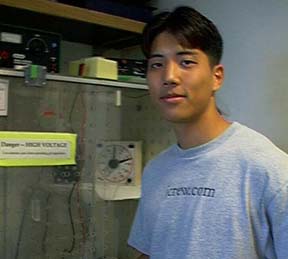
John plans to alter the specificity of a well-characterized enzyme (IDH) from its natural substrate to a close relative (IPM) by using a process called directed evolution via random mutagenesis. Challenging a holy grail in biochemistry, John will attempt to change the specificity of the enzyme without losing its catalytic power. Although past attempts at rational protein design have produced only limited success, random mutagenesis is a promising new technique in which evolution that normally takes millions of years is compacted into a few months. John’s research will lead to […]
Jonathan Clingan
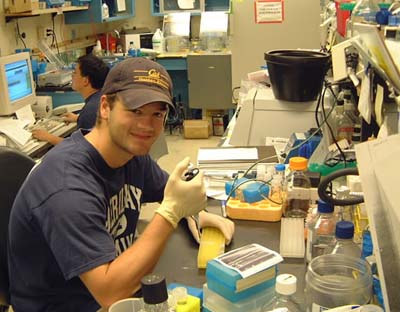
Human cytomegalovirus (HCMV) is a member of the herpesvirus family, and a major cause of disease in people with compromised immune systems, particularly AIDS patients. Through the course of Jonathan’s research, several viral mutants that exhibit a severely attenuated ability to grow in cell culture have been identified. Jonathan will study the function of a protein encoded by open reading frame (ORF) UL 21, in which a mutation causes significantly attenuated growth. Through the process of recombination, the protein can be labeled using an epitope tag. Using antibodies that are […]
Dang Khoa Lam
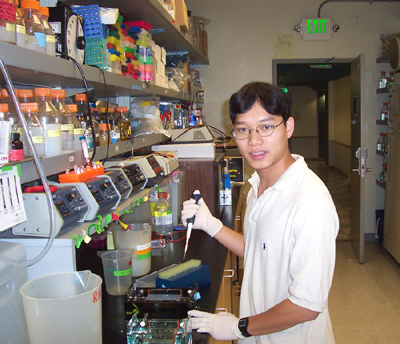
Under the guidance of Dr. Richard Harland and two postdoctoral fellows, Dr. Timothy Grammer and Dr. Mustafa Khokha, Dang will study the novel grinch mutation that affects the lymphatic system of the frog Xenopus tropicalis. Like humans, frogs have a lymphatic system which drains fluids from tissues back to the bloodstream. The lymphatic system influences the course of many human diseases, from lymphedema to tumor metastasis; and currently little is known about the molecular basis of lymphatic development. Dang’s efforts will ultimately result in the characterization and identification of the […]
Christina Marie Hamilton

Marine-atmosphere gas exchange plays a major role in the global carbon cycle. A key parameter of oceanic CO2 uptake and sequestration is the biological carbon pump (BCP). The BCP is composed of planktonic organisms that fix CO2 in photosynthesis, converting it to food and tissue. The biomass of these organisms turns over about once every week, exporting the carbon they contain away from the ocean-atmospheric interface to greater oceanic depths as they are consumed and expelled in the form of particulate organic carbon aggregates. This process, known as sedimentation, is […]
Natalia Oleg Glebova
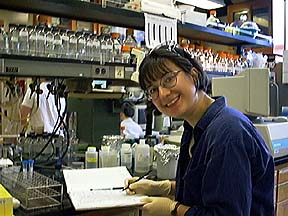
Natalia’s Senior Honors Thesis in Biochemistry and Molecular Biology evolves out of her passionate commitment to contribute to the restoration of the environment, a matter she believes should be a priority for modern society. She will be investigating the molecular mechanisms of selenite detoxification in the bacterium Bacillus subtilis, focusing on the function of the proteins thioredoxin and thioredoxin reductase in toxic metal biotransformation. The results of her research will lead to improved bioremediation of selenite-contaminated soil and water and, more broadly, to a better understanding of the practical use […]
Umair Khan
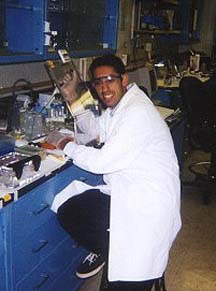
For his Senior Honors Thesis in Molecular & Cell Biology, Umair will investigate the effects of a protein co-factor on the interactions between RNase P ribozyme and a model mRNA substrate. His research will deepen our understanding of how the protein co-factor affects the sequence-specific ribozyme’s structure and activity as it cleaves an mRNA encoding thymidine kinase of herpes simplex virus 1. By revealing how the ribozyme interacts with the viral mRNA, Umair will provide insight into the engineering of sequence-specific ribozymes as antiviral therapeutic agents, with important applications for […]